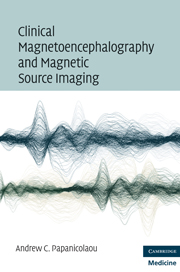Book contents
- Frontmatter
- Contents
- Contributors
- Preface
- Section 1 The method
- Section 2 Spontaneous brain activity
- Section 3 Evoked magnetic fields
- 19 Recording evoked magnetic fields (EMFs)
- 20 Somatosensory evoked fields (SEFs)
- 21 Movement-related magnetic fields (MRFs) – motor evoked fields (MEFs)
- 22 Auditory evoked magnetic fields (AEFs)
- 23 Visual evoked magnetic fields (VEFs)
- 24 Language-related brain magnetic fields (LRFs)
- 25 Alternative techniques for evoked magnetic field data – future directions
- Postscript: Future applications of clinical MEG
- References
- Index
19 - Recording evoked magnetic fields (EMFs)
from Section 3 - Evoked magnetic fields
Published online by Cambridge University Press: 01 March 2010
- Frontmatter
- Contents
- Contributors
- Preface
- Section 1 The method
- Section 2 Spontaneous brain activity
- Section 3 Evoked magnetic fields
- 19 Recording evoked magnetic fields (EMFs)
- 20 Somatosensory evoked fields (SEFs)
- 21 Movement-related magnetic fields (MRFs) – motor evoked fields (MEFs)
- 22 Auditory evoked magnetic fields (AEFs)
- 23 Visual evoked magnetic fields (VEFs)
- 24 Language-related brain magnetic fields (LRFs)
- 25 Alternative techniques for evoked magnetic field data – future directions
- Postscript: Future applications of clinical MEG
- References
- Index
Summary
Overview
The capacity to identify relatively small cortical patches that show transient increases in neurophysiological activity (i.e., signaling between neuronal populations) renders MEG suitable for a variety of clinical applications that target stimulus-evoked activity, either during passive stimulation conditions or while the patient is performing a cognitive or linguistic task.
The main purpose of the latter studies is to determine the location and extent of cortex that mediates visual, auditory, somatosensory, motor, and language functions relative to brain regions that need to be surgically removed (e.g., epileptogenic zones or tumors). The goal of these procedures is to reduce the morbidity (i.e., postoperative deficits) that may result if cortical regions containing indispensable components of the brain mechanism for a particular function are compromised during surgery.
A brain mechanism is defined by a set of events that take place in particular brain areas in a particular order and result in the generation of the phenomena, either behavioral or psychological (e.g., perceptual responses), that define each function. When the mechanism is operating, a particular pattern of activation occurs, but this pattern may be difficult to see because it is embedded in the global profile of baseline activity. To isolate the activation pattern for a particular function, a laboratory situation must be contrived to elicit the naturally occurring function on demand, while the participant's brain activity – and activation pattern – is recorded. Stimuli of the same kind as those that naturally trigger the function are presented to the patient.
- Type
- Chapter
- Information
- Clinical Magnetoencephalography and Magnetic Source Imaging , pp. 111 - 117Publisher: Cambridge University PressPrint publication year: 2009



